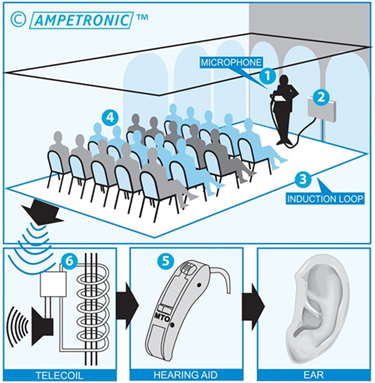An induction loop, also known a a hearing loop or T-Loop, is an assistive listening system that helps those with T-Coil equipped hearing aids – about 80% of hearing devices currently in use in the United States. It takes a sound source – such as a PA system – and transmits it directly to the user’s hearing aid without the ambient room noise. Since the sound is produced by the wearer’s own hearing aid, users hear better than with most other systems… and without the fuss of extra headsets. The presence of an induction loop in a public place is indicated by the presence of the hearing loop sign.
Over the last 30 years, hearing loops have become the default assitive listening solution in Europe, Scandinavia, and Australasia, and are now becoming increasingly prevalent in America. Due to their benefits and ease of use, they can be found in locations as diverse as taxis, schools, houses of worship, concert halls and stadiums.
- A sound source, such as a voice, TV, movie sound system or other audio system is captured using a microphone or a line out connection.
- The sound signal is then connected to an audio induction loop amplifier which generates a current to an induction loop, usually made of copper wire or tape.
- The induction loop usually surrounds the area where the audience is located and produces a magnetic field.
- The magnetic field is picked up by the T-Coil (or Telecoil) inside the hearing aids worn by the audience.
- The hearing aid tailors the sound to the specific needs of the individual. Sound is delivered directly into the ear canal, without ambient room noise and with the full spectrum of sound frequencies required for intelligibility.
The number of users who can benefit from the system at one time is only limited by the number of people that can fit in the “looped” area. Expensive receivers are not required and users don’t suffer the inconvenience of asking for and wearing a headset.
Hearing loops are an inherently simple technology, but care should be taken (and professional advice sought) in their design, specification and installation so that the facility conforms to the International Standard for operation and gives the most benefit to the end user.
Printable PDF: What Is A Hearing Loop? (May take a few seconds to load)
Printable PDF: What Is a T-Coil? (May take a few seconds to load)

